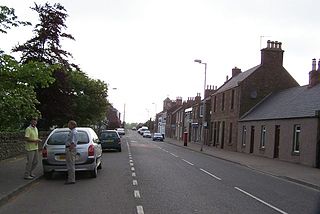Related Research Articles

Earl of Balcarres is a title in the Peerage of Scotland, created in 1651 for Alexander Lindsay, 2nd Lord Balcarres. Since 1848, the title has been held jointly with the Earldom of Crawford, and the holder is also the hereditary clan chief of Clan Lindsay.

Viscount of Arbuthnott is a title in the Peerage of Scotland. It was created in 1641, along with the subsidiary title Lord Inverbervie, for Sir Robert Arbuthnott. The Viscount of Arbuthnott is the hereditary chief of Clan Arbuthnott.

Baron Lawrence, of the Punjab and of Grateley in the County of Southampton, was a title in the Peerage of the United Kingdom. It was created in 1869 for Sir John Lawrence, 1st Baronet, the former Viceroy of India. He had already been created a Baronet, in 1858. His son, the second Baron, served in the Conservative administrations of Lord Salisbury and Arthur Balfour as a government whip from 1895 to 1905. The title became extinct on the death of the fifth Baron on 14 August 2023.

Friockheim is a village in Angus, Scotland dating from 1814. It lies between the towns of Arbroath, Brechin, Forfar and Montrose.

John Carnegie, 1st Earl of Northesk (1611–1667), was a Scottish noble who supported the Royalist cause during the Wars of the Three Kingdoms.
John Bruce-Gardyne, Baron Bruce-Gardyne, was a British Conservative Party politician.

Clan Guthrie is a Scottish clan.

Clan Irvine is a Scottish clan.

Clan Swinton is a Scottish clan of the Scottish Lowlands.

Finavon Castle lies on the River South Esk, about a quarter of a mile south of Milton of Finavon village and five miles to the north-east of Forfar in Angus, Scotland. The name is applied both to a ruined 17th-century castle, as well as the 19th-century mansion house 130m to the west.
John MacLeod of MacLeod, born John Wolrige-Gordon was the 29th Chief of Clan MacLeod. Faced with the need for expensive repairs to the clan's seat at Dunvegan Castle on the Isle of Skye, his proposed methods to raise funds caused considerable controversy. His twin brother, Patrick Wolrige-Gordon (1935–2002), was MP for East Aberdeenshire.
Sir Michael Hugh Shaw-Stewart, 8th Baronet was a Scottish politician, soldier and landowner.
Gardyne is a Scottish surname from the county of Angus. The family or Clan Gardyne originated in the environs of Gardyne Castle; their seat was Friockheim, Angus, Scotland.

Clan Gardyne is a lowland Scottish clan from Angus

The Douglases of Mains are a branch of the Clan Douglas, related to the Lords of Douglas through Archibald I, Lord of Douglas. The first Laird obtained land through marriage into the Galbraith family, which had been granted land in New Kilpatrick by Maldowen, Earl of Lennox. The family produced minor nobles in the Scottish court, perhaps the most notable of which was Malcolm Douglas, the 8th Laird, executed for treason in Edinburgh for conspiracy in the Raid of Ruthven. His second son, Robert Douglas, was made Viscount of Belhaven and is buried in Holyrood Abbey. The family intermarried in the Glasgow area, having links with the Campbells of Blythswood, with landed families across Scotland and more latterly the United Kingdom. The title became extinct in the 20th century; the last 33+1⁄2 acres of the estate was sold to Dunbartonshire county and was subsequently used for the erection of the secondary school, Douglas Academy, in Milngavie prior to the death of the last heir in 1977.
Thomas Gardyne of Middleton and Finavon (1780–1841) was a Scottish laird and founder of the village of Friockheim in Angus, Scotland.
William Lindsay, 18th Earl of Crawford and 2nd Earl of Lindsay was a Scottish noble and politician.

John Lindsay, 17th Earl of Crawford, 1st Earl of Lindsay was a Scottish nobleman.
Sir William de Lindsay (1155–1205), Lord of Crawford, Baron of Luffness, Justiciar of Lothian was a 12th-century Scottish noble.
Robert Lindsay, 9th Lord Lindsay PC, was a Scottish landowner.
References
- Peter Beauclerk Dewar, ed. (2001). Burke's landed gentry of Great Britain (19th ed.). Burke's Peerage and Gentry LLC. pp. 486–487. ISBN 0-9711966-0-5.